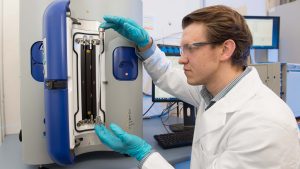FineFuture consortium partners provide solutions to valorise fine mineral particles from mine tailing waste.
One of the biggest challenges that the raw material industry faces is treating mineral and metalliferous fine-grained materials. Novel, energy-efficient, and groundbreaking separation/beneficiation technologies are needed to shift the current mining paradigm towards exploiting natural mineral deposits that are very fine-grained (below 20μm particle size).
FineFuture is an EU funded project aimed at developing ground-breaking technological solutions for significantly improving fine particle flotation based on new scientific knowledge. Separating very fine particles is essential for the valorisation of multiple mineral and metalliferous resources (e.g. copper, nickel, iron, lead, zinc, fluorite, kaolinite, feldspar, magnesite, REE, tungsten, tin, graphite, etc.) and will help to secure both global sales by European companies and the production of Critical Raw Materials (CRMs) within Europe. CRMs define raw materials of high importance to the EU economy which have a high risk associated with their supply. Shortage in the supply of CRMs would hinder economic growth in rapidly developing industrial areas such as energy storage systems and other emerging technologies.

Key technologies
FineFuture’s newly developed technologies recovering fine particle systems would not be restricted to a particular deposit class, but the research will pave the way towards applicability for all classified CRMs. The FineFuture consortium is convinced from their experience, expertise, and stakeholder knowledge that hetero-coagulation separation technologies, in particular froth flotation, will remain the key technologies for mineral particle processing as well as in recycling. Flotation needs to be entirely re-engineered to separate very fine particles of the resources at a large scale through cutting-edge technological investigations guided by industrial partners. Unique aspects of the research work are a parallel dialogue with broader public and professional stakeholders to inform and receive feedback for better applicability and societal trust. The expected results will lead to a drastically reduced loss of resources, the utilisation of new resources, and more competitiveness, likely delivering on higher energy and water efficiency as well.
Martin Rudolph, Co-ordinator at HZDR, said: “Our solutions comprise improved turbulent hydrodynamic design solutions of especially pneumatic flotation cells including the positive effects of microbubbles as well as the computer chemical assisted development and choice of flotation reagents.”
Consortium Partners
Helmholtz-Zentrum Dresden-Rossendorf;
Aristotle University of Thessaloniki;
BASF;
Eramet Group;
GRECIAN MAGNESITE;
Imperial College London;
Industrial Minerals Association – Europe;
Łukasiewicz Research Network – Institute of Non-Ferrous Metals (Ł-IMN);
Istanbul Technical University;
KGHM;
Maelgwyn Mineral Services;
Magnesitas Navarras;
Politecnico di Milano;
Sofia University St. Kliment Ohridski;
Université de Lorraine; and
Turboflotservice (TFS)
Martin Rudolph
Head, Department of Processing at Helmholtz-Institute Freiberg for Resource Technology
Project Co-ordinator
Fine Future
m.rudolph@hzdr.de
https://finefuture-h2020.eu/
Please note, this article will also appear in the sixth edition of our quarterly publication.







